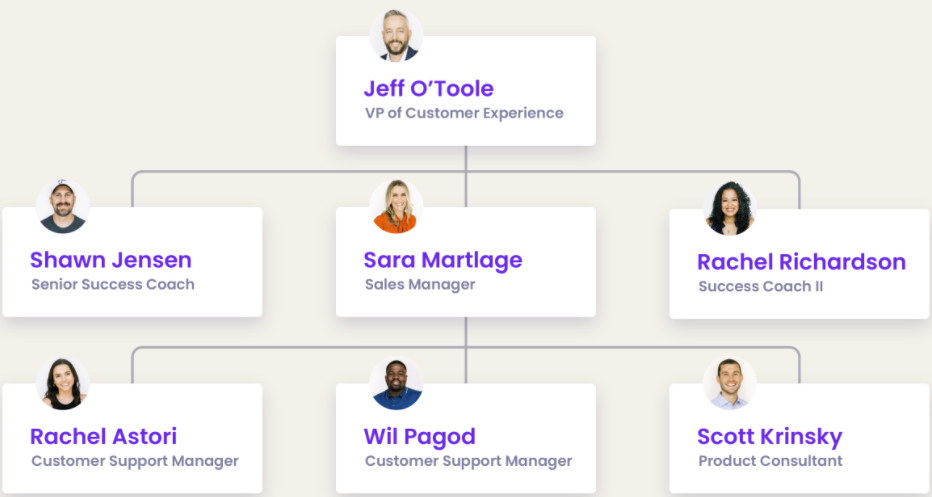
Articles
3 Types of Nonprofit Organization Structure [+How to Create a Nonprofit Organization Chart]
March 31, 2022

One of the most effective ways to ensure that your nonprofit staff knows their role (and everyone else's) is to create a nonprofit org chart. That chart is a construct of and is a visual depiction of the nonprofit's organizational structure.
Once upon a time, you were the new kid on the block at work. Did you know who every coworker was and what they were responsible for? Ever report to the wrong person or submit a project to a teammate who had resigned two months before?
We’re willing to bet you didn’t have access to an employee organizational chart. And that you probably reported to the wrong person a few (dozen) times — right?
A nonprofit org chart can help you create job descriptions and hire great employees — but they also serve as a mirror for how you present your nonprofit to investors and the public at large.
Before you build a nonprofit organization chart, you must have the nonprofit org structure in place? So let’s talk org structures first.
3 common types of nonprofit organizational structures
An organizational structure defines how roles, power, and responsibilities are assigned and coordinated within an organization. It shows the chain of command from the leader to the staff on the ground and within departments.
Every nonprofit organization is different, especially when it comes to its hierarchical structure. While there are common organizational layouts you can use, you can always customize your org chart to best reflect your inner workings.
Here are the three common nonprofit organization structures:
1. Flat
If the majority of your team members self-manage and spearhead their projects autonomously, then a flat org chart layout might be right for you.
Under this structure, your employees usually have a clear understanding of their roles, and they report directly to the Board of Directors, whenever necessary.
2. Cross-functional
If you have a small nonprofit where everyone’s taken on multiple roles, then a cross-functional org structure might be ideal for you.
Under this model, the chart will align team members according to their roles. Here, the reporting lines are laid out, so everyone understands who they need to report to.
3. Matrix
Depending on how large your nonprofit is, a matrix organizational structure might be a better fit — especially if you run a medium or large team with multiple departments.
A matrix structure often combines two or more different org structures to best capture the complexity of your org.
Now that you have your non-profit organization structure lad out, you can draw your nonprofit organization chart:
What’s a nonprofit organizational chart?
A nonprofit organizational chart (aka, a hierarchy chart) is an easily-digestible, one-page visual representation of who works in your organization. It details what role they have, what their responsibilities are, and who they report to.
This chart should show clear reporting lines so everyone in the organization understands who they need to contact or report to. A nonprofit org chart is very similar to most other employee organizational charts.

Only, with a nonprofit org chart, the internal organizational structure is different. Instead of a CEO, a nonprofit will likely have an executive director and board of directors at the top of its org chart.
Why do you need a nonprofit organizational chart?
Everyone working for your nonprofit, regardless of their position, needs a crystal clear understanding of their role and its importance in the organization. You don’t want any team member just skating by.
They need to know what they’re specifically responsible for. An org chart can help your team remain in the know, stay engaged, and even keep your turnover rate on the low end.
When everyone knows what they’re supposed to be doing and who to contact when they don’t, they’ll likely be more content and productive in their role.
How to create a nonprofit organizational structure chart (in 5 steps)
Before you sit down to create your nonprofit org chart, there is information that you must collect first. This information is unique to your organization and needs to be accurate for org chart to be a true depiction of how your nonprofit is structured.
Here are some of the most common things you’ll need to begin:
- A comprehensive list of your employees.
- Recent pictures of each of your employees for easy identification.
- A detailed rundown of every employee’s role and responsibilities.
- A clear understanding of your non profit corporate structure.
- An updated list of who reports to who and for what.
While you can manually create your nonprofit org chart, there are tools you can use to save tme and ensure accuracy. These include:
- Canva
- Draw.io
- Microsoft Office
- Airtable
- Pingboard
- SmartArt
- Indesign
Right, here are the steps to build your nonprofit organizational chart:
1. Know your non profit organization hierarchy.
Your staff (and leadership, of course), need a clear understanding of the hierarchy of your non profit organization and how the non profit organizational structure operates.
Let them know who the decision makers are.
How do your board members (and groups, committees, divisions, etc.) work together? Do you operate according to a flat structure or a cross-functional one?
With information comes power, so approaching your org chart creation process with a solid picture of how you operate will only make the process smoother — and more productive.
2. Define your reporting lines within your nonprofit hierarchy.
If you’ve experienced turnover, perhaps from interns returning to school or from employees who are moving on, the odds are your reporting lines have experienced serious disruption.
With turnover comes vacancies, and no matter how brief, this can confuse your remaining team members.
The lines of communication and reporting structure must be clear to the department and between or among your departments.
3. Choose the best tool for your non profit organization chart.
As a nonprofit org, you might not have access to an in-house graphic design team who’s able to create five different org chart mockups for your viewing pleasure (and if there is, you’re doing something right!).
The great news is, creating an org chart doesn’t have to be complicated.
Whether you opt for Canva, SmartArt options in MS Office, or InDesign, the key is to go for a tool that best mirrors your org.
4. Determine your ideal nonprofit org chart type.
How you organize your org chart depends on your nonprofit’s culture.
For example, do you have a vertical reporting nonprofit structure? Or, is everyone operating on more of an equal, decision-making playing field?
Whatever the structure of your nonprofit, be sure to customize your org chart to reflect your situation and meet your needs.
5. Populate the non profit hierarchy chart with staff and their roles.
Think of this step as an org chart version of paint-by-numbers. This is where you get to upload everyone’s recent profile pic, take liberties with the font and style, and get creative with design.
Sometimes, creating a visual representation of your non profit hierarchy can inspire new perspectives. As you list the details of each role, and reconfigure the layout and colors in the org chart, feel free to unleash your creative flair.
Final considerations to keep in mind for the org structure and chart for your nonprofit
Think of your nonprofit organizational chart as a living document — similar to an in-house policy or a law. It’s subject to change — so, expect it to change! Commit to regularly updating your chart to prevent unnecessary confusion and delays in your productivity.
Here are the top three considerations to keep in mind as you finalize your org chart:
Logical and easily readable
Ask yourself: does my chart make sense? And then ask other people the same question. Solicit feedback from your team or from a few folks outside of your organization — those who are less familiar with your inner workings.
Use a few (or all) of these questions to solicit targeted feedback:
- Can you tell me who team member X reports to?
- What is team member Y’s role?
- Who would team member Z report to with a question regarding student loan forgiveness as an employee of a nonprofit?
- What doesn’t make sense to you?
Easily accessible
Every member of your nonprofit needs easy access to your org chart. That means you need to post it somewhere it can be used and ensure that more than just a few people can access it (and use it).
Besides uploading your org chart onto your website, you can also incorporate it into your nonprofit business playbook. Your nonprofit’s playbook is the same place you keep your policies, standard operating procedures (SOPs), and processes.
Add to this, the need for public transparency as a nonprofit organization. You’ll want to give the general public, including patrons and donors, access to who does what in your org.
Prepare to adapt as you grow and scale
Employees come and go. One minute you’re starting out and then the next thing you know, you’re ready to scale. Embrace that change — and make adjustments to your org chart along the way.
As your nonprofit grows and scales, you’ll need to update your hierarchy chart.
Whether that means adding new positions and roles, eliminating others, or redefining existing reporting lines, go ahead and embrace change. And commit to updating your org chart as frequently as necessary — there’s no ceiling.
Ready for an org chart that’s more than just names and roles??
You want to keep your nonprofit teammates happy, productive, and, of course, in your organization for the long haul. An org chart can help define job responsibilities/roles as well as who to contact when they need to.
Equipping your team with the best tools for success can create a positive ripple effect across your nonprofit. And that begins with providing each employee with clarity about their role, and how they connect with the rest of the team.
Similar Blog Posts










